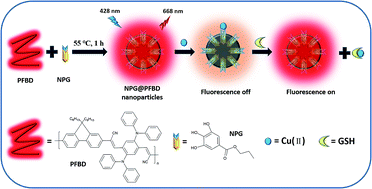当前位置:
X-MOL 学术
›
Anal. Methods
›
论文详情
Our official English website, www.x-mol.net, welcomes your
feedback! (Note: you will need to create a separate account there.)
Determination of Cu2+ and biothiols by novel red fluorescent hybrid nanoparticles†
Analytical Methods ( IF 2.7 ) Pub Date : 2018-05-02 00:00:00 , DOI: 10.1039/c8ay00614h Ling Zhang 1, 2, 3, 4 , Zizhun Wang 1, 2, 3, 4 , Jiaze Hou 1, 2, 3, 4 , Lulu Lei 1, 2, 3, 4 , Jiao Li 1, 2, 3, 4 , Juan Bai 1, 2, 3, 4 , Hui Huang 1, 2, 3, 4 , Yongxin Li 4, 5, 6, 7, 8
Analytical Methods ( IF 2.7 ) Pub Date : 2018-05-02 00:00:00 , DOI: 10.1039/c8ay00614h Ling Zhang 1, 2, 3, 4 , Zizhun Wang 1, 2, 3, 4 , Jiaze Hou 1, 2, 3, 4 , Lulu Lei 1, 2, 3, 4 , Jiao Li 1, 2, 3, 4 , Juan Bai 1, 2, 3, 4 , Hui Huang 1, 2, 3, 4 , Yongxin Li 4, 5, 6, 7, 8
Affiliation

|
Red fluorescent hybrid nanoparticles (NPG@PFBD) have been designed and synthesized successfully. The NPG@PFBD nanoparticles are composed of a fluorescent semiconducting polymer (PFBD) and n-propyl gallate (NPG). Because of the coordination between the gallate and Cu2+, Cu2+ could attach to the hybrid nanoparticles and quench their fluorescence through photoinduced electron transfer (PET). In addition, in the presence of biothiols, such as glutathione (GSH), Cu2+ would bind to the thiol. The PET between the hybrid nanoparticles and Cu2+ was weakened, and the fluorescence signal of the nanoparticles was recovered. A facile detection method for Cu2+ and biothiols was therefore developed. The detection limit for Cu2+ and GSH was 40 nM and 90 nM, respectively. The proposed fluorescent hybrid nanoparticles have great potential application for Cu2+ and GSH detection in related biological fields.
中文翻译:

新型红色荧光杂化纳米颗粒 测定铜2+和生物硫醇†
红色荧光杂化纳米粒子(NPG @ PFBD)已被成功设计合成。NPG @ PFBD纳米粒子由荧光半导体聚合物(PFBD)和没食子酸正丙酯(NPG)组成。由于没食子酸酯和Cu 2+之间的配位,Cu 2+可以附着在杂化纳米颗粒上并通过光致电子转移(PET)猝灭其荧光。另外,在存在生物硫醇如谷胱甘肽(GSH)的情况下,Cu 2+会与硫醇结合。杂化纳米粒子与Cu 2+之间的PET减弱,纳米粒子的荧光信号得以恢复。Cu 2+的简便检测方法因此开发了生物硫醇。Cu 2+和GSH的检出限分别为40 nM和90 nM。提出的荧光杂化纳米粒子在相关生物领域中对Cu 2+和GSH的检测具有巨大的潜在应用价值。
更新日期:2018-05-02
中文翻译:

新型红色荧光杂化纳米颗粒 测定铜2+和生物硫醇†
红色荧光杂化纳米粒子(NPG @ PFBD)已被成功设计合成。NPG @ PFBD纳米粒子由荧光半导体聚合物(PFBD)和没食子酸正丙酯(NPG)组成。由于没食子酸酯和Cu 2+之间的配位,Cu 2+可以附着在杂化纳米颗粒上并通过光致电子转移(PET)猝灭其荧光。另外,在存在生物硫醇如谷胱甘肽(GSH)的情况下,Cu 2+会与硫醇结合。杂化纳米粒子与Cu 2+之间的PET减弱,纳米粒子的荧光信号得以恢复。Cu 2+的简便检测方法因此开发了生物硫醇。Cu 2+和GSH的检出限分别为40 nM和90 nM。提出的荧光杂化纳米粒子在相关生物领域中对Cu 2+和GSH的检测具有巨大的潜在应用价值。











































 京公网安备 11010802027423号
京公网安备 11010802027423号